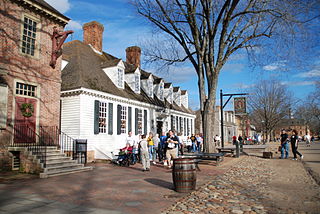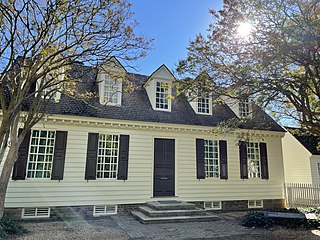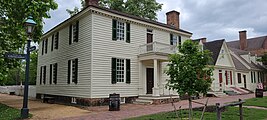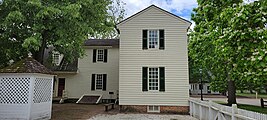
Colonial Williamsburg is a living-history museum and private foundation presenting a part of the historic district in the city of Williamsburg, Virginia. Its 301-acre (122 ha) historic area includes several hundred restored or recreated buildings from the 18th century, when the city was the capital of the Colony of Virginia; 17th-century, 19th-century, and Colonial Revival structures; and more recent reconstructions. The historic area includes three main thoroughfares and their connecting side streets that attempt to suggest the atmosphere and the circumstances of 18th-century Americans. Costumed employees work and dress as people did in the era, sometimes using colonial grammar and diction.

The Colonial Revival architectural style seeks to revive elements of American colonial architecture.

William Archer Rutherfoord "W. A. R." Goodwin was an Episcopal priest, historian, and author. As the rector of Bruton Parish Church, Goodwin began the 20th-century preservation and restoration effort which resulted in Colonial Williamsburg in Virginia. He is thus sometimes called "the Father of the Restoration of Colonial Williamsburg."

The Governor's Palace in Williamsburg, Virginia, was the official residence of the royal governors of the Colony of Virginia. It was also a home for two of Virginia's post-colonial governors, Patrick Henry and Thomas Jefferson, until the capital was moved to Richmond in 1780, and with it the governor's residence. The main house burned down in 1781, though the outbuildings survived for some time after.

The Capitol at Williamsburg, Virginia housed both Houses of the Virginia General Assembly, the Council of State and the House of Burgesses of the Colony of Virginia from 1705, when the capital was relocated there from Jamestown, until 1780, when the capital was relocated to Richmond. Two capitol buildings served the colony on the same site: the first from 1705 until its destruction by fire in 1747; the second from 1753 to 1780.

Carter's Grove, also known as Carter's Grove Plantation, is a 750-acre (300 ha) plantation located on the north shore of the James River in the Grove Community of southeastern James City County in the Virginia Peninsula area of the Hampton Roads region of Virginia in the United States.
Thomas Everard (1719–1781) served as mayor of Williamsburg, Virginia from 1766 to 1767. He was a clerk at the House of Burgesses and lived in the Brush-Everard House in Colonial Williamsburg. He supported the fight for independence from the British Empire, including serving on the committee that selected delegates from Virginia for the Continental Congress.

Bassett Hall is an 18th-century farmhouse located in Williamsburg, Virginia. It was the home of John D. Rockefeller Jr. and his wife Abby Aldrich Rockefeller during the restoration of Colonial Williamsburg.

Vernon Meredith Geddy Sr. was an attorney based in Williamsburg, Virginia. He attended the College of William and Mary and the University of Virginia, and served W&M as the head coach for the William & Mary Tribe men's basketball team for the 1918–19 season.

The Wythe House is a historic house on the Palace Green in Colonial Williamsburg, in Williamsburg, Virginia, USA. Built in the 1750s, it was the home of George Wythe, signer of the Declaration of Independence and father of American jurisprudence. The property was declared a National Historic Landmark on April 15, 1970.

The Colonial Williamsburg Courthouse was constructed from 1770 to 1771 in the Georgian style. The courthouse is located facing Market Square with Duke of Gloucester Street running directly behind it. The property was acquired by Colonial Williamsburg in 1928, and was added to the National Register as a contributing property to the Williamsburg Historic District on October 15, 1966.

The Edenton Tea Party was a political protest in Edenton, North Carolina, in response to the Tea Act, passed by the British Parliament in 1773.
Philip Rundell (1746–1827) was a highly prosperous English jeweller, fine jewellery retailer and master jewellery makers' business proprietor, known for his association with royalty. With John Bridge, he ran and co-owned Rundell and Bridge, a firm with widespread interests in the jewellery and precious metal trades.
Lucy Burwell Page Saunders was an American writer.

The Williamsburg Bray School was a school for free and enslaved Black children founded in 1760 in Williamsburg, Virginia. Opened at Benjamin Franklin's suggestion in 1760, the school educated potentially hundreds of students until its closure in 1774. The house it first occupied is believed to be the "oldest extant building in the United States dedicated to the education of Black children".
Ann Wager was a teacher and schoolmistress in colonial Williamsburg, Virginia.

The Brush-Everard House, also known as the Everard House and Thomas Everard House, was built by John Bush ca. 1718. One of the oldest houses in Virginia and in Williamsburg, it is located on the east side of Palace Green and next to the Governor's Palace. It is a "five-bay, timber framed, story-and-a-half house of hand-split weatherboard".

Gowan Pamphlet (1748–1807) was an American Baptist minister and freedman who founded the Black Baptist Church in Williamsburg, Virginia, United States. He was one of the first and, for a time, the only ordained African American preacher of any denomination in the American Colonies.
Edith Cumbo was a free mixed-race Black woman and entrepreneur who lived in Williamsburg, Virginia. Her life story is taught in American history curriculum to illustrate the challenges that free African Americans faced during the period of the American Revolution.
Lydia "Liddy" Broadnax was an American free Black woman, former enslaved person, and businesswoman who lived in Williamsburg and later Richmond, Virginia. Some historians have suggested that Broadnax was a concubine of her former enslaver and later employer, Founding Father of the United States George Wythe. She was denied the right to testify in the trial regarding his murder because of her race.


















